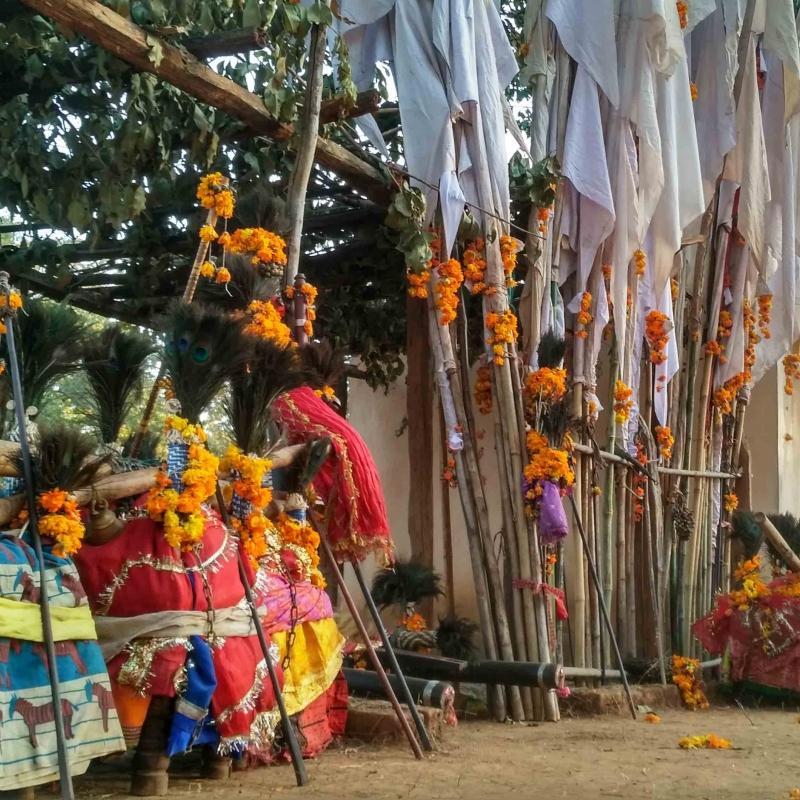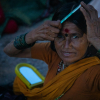Introduction
Unlike the other Madais of Bastar, the one at Geedam is significant. Madai at Geedam marks the culmination of pen (ancestral gods) Madais across Bastar and marks the beginning of ama (mango) Madai—i.e., celebration of the mango season. Geedam Madai and the Dantewada Madai were started by king Annamdev of the Kakatiya dynasty who was blessed by Maa Danteshwari, the kuldevi (ruling deity) of the ruling dynasty of Bastar. Most of the ritual celebrations in Bastar region begin and end with the worship of this guardian deity and her local avatar in the regions adjacent to the regal capital.
The myths and legends built around Danteshwari and her various incarnations are intricately connected with the Madais of Bastar in general and of Geedam and Dantewada in particular. A brief digression into the exploration of the various myths and legends might help us to understand why the Madais of Geedam, Dantewada and Jagdalpur are not just considered to be very important but also connected through proto-regal umbelicus.
Myths around Danteshwari
There are at least two popular myths around the formation of the region of Bastar. While one of them was popular amongst the Adivasis, especially the Gonds, the other was more popular amongst the upper caste Hindus who reside in the towns of Bastar, Jagdalpur, Dantewada and Geedam.
In the course of a conversation that revolved around the origin of Bastar and the tradition of Madais, Pandit Ram Nareti, a Gondi scholar, a wood carver and community leader, narrated to us the myth of the origin of the place—it was a myth that was associated with Dantewada. He shared how Dantewada was the manifestation of a blessing endowed upon King Annamdev by Danteshwari devi. According to the myth, Danteshwari devi had blessed the king with a boon that the distance the king could cover while holding his face upright would become a part of his territory; and, during all this while, the goddess would walk behind the king to ensure his safety. However, there was only one condition that during the journey the king would not stop to turn around, else the devi would no longer accompany him. Thus, the king began walking from Basroor. According to the instructions, Raja Annamdev walked in front of Danteshwari upto Rajim, the riverside of Pairi. As the Raja walked ahead, he realized he could no longer hear the sound of the devi's anklets, which were an indication that the goddess was walking behind him. Ridden with doubt that the devi had abandoned him, he turned around and found that the devi was still there with him, but it was due to the sand in the riverbed that he could no longer hear her anklets. As per the condition, Danteshwari could no longer accompany Annamdev any further since the king had turned around. At that juncture, she blessed him and vowed to protect 22 generations after him. She gifted him with a fine cloth and told him that the area under the cloth would confine the borders of his territory. It is quite possible that the state acquired its name ‘Bastar’ from this cloth. Consequently, Annamdev's kingdom got established from Warangal to Barsoor, then from Barsoor to Dantewada.
The other myth, which is popular amongst the Hindus, connects the deity to a different origin where Danteshwari is seen as a form of Durga. It is believed that Dantewada is one among the 52 shakti peeths. As the legend goes, Prajapati Daksha organized a yagya(ritual offering in front of a sacrificial fire, often accompanied by chanting of mantras) where he did not invite Lord Shiva, his son-in-law. Daksha's daughter, Devi Sati, went to attend the yagya at her maternal home; infuriated by the humiliation meted out to her husband, she committed self immolation in the yagya pit. This infuriated Lord Shiva, and two of his forms—Virbhadra and Bhadrakali—emerged out of his rage; together, they destroyed Daksha’s yagya. Looking at the corpse of Sati, Lord Shiva began his famous tandav nritya (dance performed by Lord shiva in his role as destroyer of the universe) while he carried his deceased beloved's body. In order to stop the destruction caused by the enraged god, Lord Vishnu used his sudarshan chakra (a disk-like weapon) to cut Devi Sati's body into 52 parts. The spots where the remnants of Devi Sati fell, were consecrated as the 52 shakti peethas. It is believed that Danteshwari emerged out of the site where the tooth had fallen in Dandkaranya, Bastar, and thus the Danteshwari shakti shrine was established, an event that also finds mention in the Puranas.
Beyond these, there are various adivasi adaptations of these myths. In the past, when modes of transport were still inadequate, people created matagudis (places of worship) in their respective villages to worship Danteshwari in her various forms. The adivasis, especially the Gonds and the Halbas, started worshiping and addressing various incarnations of Danteshwari. There are at least 32 incarnations referred to as the batthis behna which have their own significance with different rituals of paying homage to each. Although considered to be sisters, the incarnations often merge into the larger figure of Danteshwari. Some of the important devis from the 32 sisters are Kotgudin, Pendrawadin, Kankalin, Pardesin, Mawali, Bijilikarin, Sitala, Jalnibudi, Dayamule, Gangadayi, Kesarpalin, Hingalajin, Dabagosin, Dulardeyi, Rewagdin, HirMadai, Kolakaamini, Ganganadai, Paatakadai, Peeladai, Ghaasbedindai and Semariya . Most of the adivasi sevaks(devotees) of the devis often claim that each of the batthis behna have their own territories and during the celebration of Dusshera Madai, phagun Madai and pen Madai, they come together. These devis connect all the Madais across Bastar through a vital string of kinship ties amongst the deos(gods) and the devis who are worshipped and brought together.
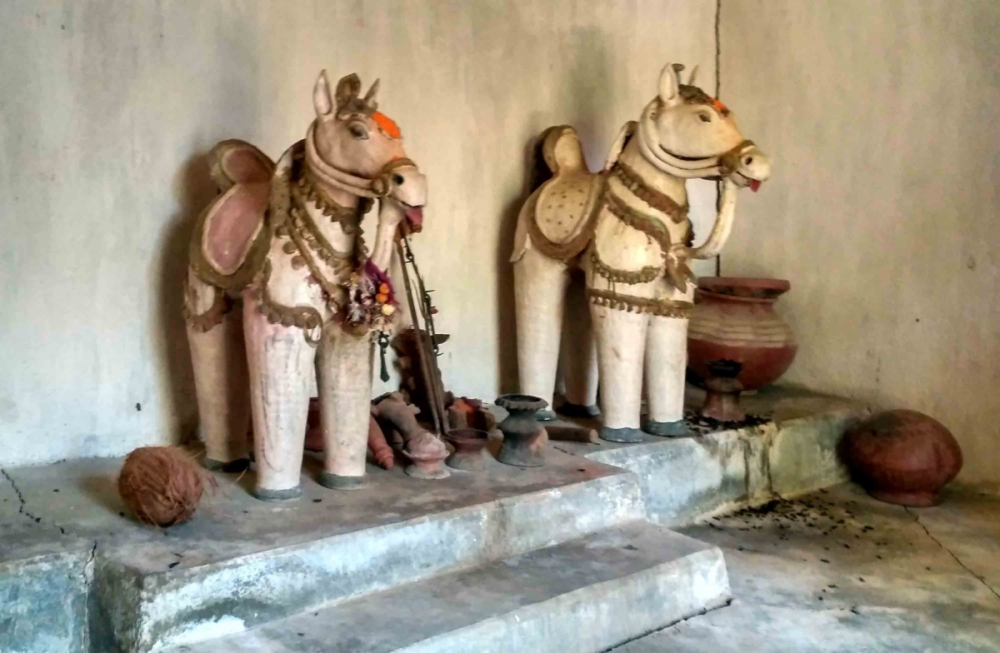
Hinglanjin
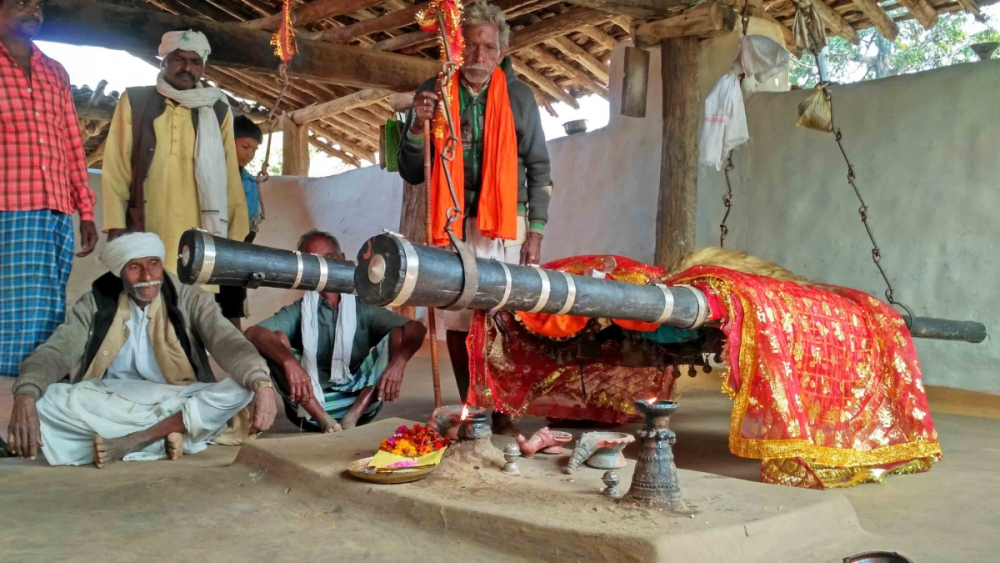
Deoni-Dokri
Events leading up to the Madai
According to the adivasi traditions, the incarnations or the sisters of Danteshwari and their families are worshipped according to the regional rituals. The Madais of Bastar often bring the adivasi and the non- adivasi ruling class together through a confluence of the devis. Although the system of beliefs and worship vary greatly, during the Madai they not only co-exist, but also blend their rituals with each others. The significance of Jagdalpur becomes crucial to understand this blending. Apart from Dantewada, a Danteshwari temple also exists at the Raj Mahal of Jagdalpur. During Dussehra, the chatra of Danteshwari is brought from Dantewada to Jagdalpur. The events preceding Dusshera continue for around three months. The first Madai hence starts with the celebration of Dussehra in Jagdalpur which is called the raj Madai by most adivasis.
Dussehra starts on hariyaali amavasya (the no moon that marks the onset of monsoon) when the trunk of a tree named turlu khotla is brought to Danteshwari’s temple. This trunk is completely used in the construction of Dussehra rathas (chariots) in the form of wooden hammer and wooden nails. Bastar Dussehra continues for 75 days and various devis (sisters of Danteshwari) and deos (who are also ancestral deities of various adivasi communities) come together. This festival ends with the departure of chatras of various devi and deos. Amongst all other devis, Maawali Mata from Narayanpur is of primary importance.
Following the Dussehra Madai at Jagdalpur, the return of the devis and the deos to their respective territories are celebrated with subsequent Madais that are held after Dussehra and continue till the spring season when the post-harvest phagun Madai is celebrated in Dantewada. Following the phagun Madai, the last pen Madai is celebrated by the adivasis in Geedam in April.
As per tradition, this year (i.e., 2018) the phagun Madai of Dantewada started on 24th February and continued for ten days. The doli (the palanquin and the chatra of the devi) was carried along with its procession for nine days around Dantewada.
The realm of ancestral gods and the realm of men
The word, Madai, literally translates into a ‘meeting’. It is the meeting of the ancestral gods of the adivasis with their kins, of the Vedic/Vedantic goddess with their earthly adaptations, of men and women with their kins and friends and finally that of gods with each other and with men through the vehicles of the human body and the anga, dang and doli. The carriers of the anga, dang and doli are often possessed, and it is believed that are driven by the divine energy of their ancestors or of the devi.
The possessed state of the human body by an ancestral god is a common sight during a pen Madai. The body is possessed when the sevaks pick up the doli, dang or the anga of their respective ancestors. Once possessed, it is believed that the ancestors would communicate through gestures and body movements and would warn against, or appreciate certain decisions that the adivasi samaj (society) would take.
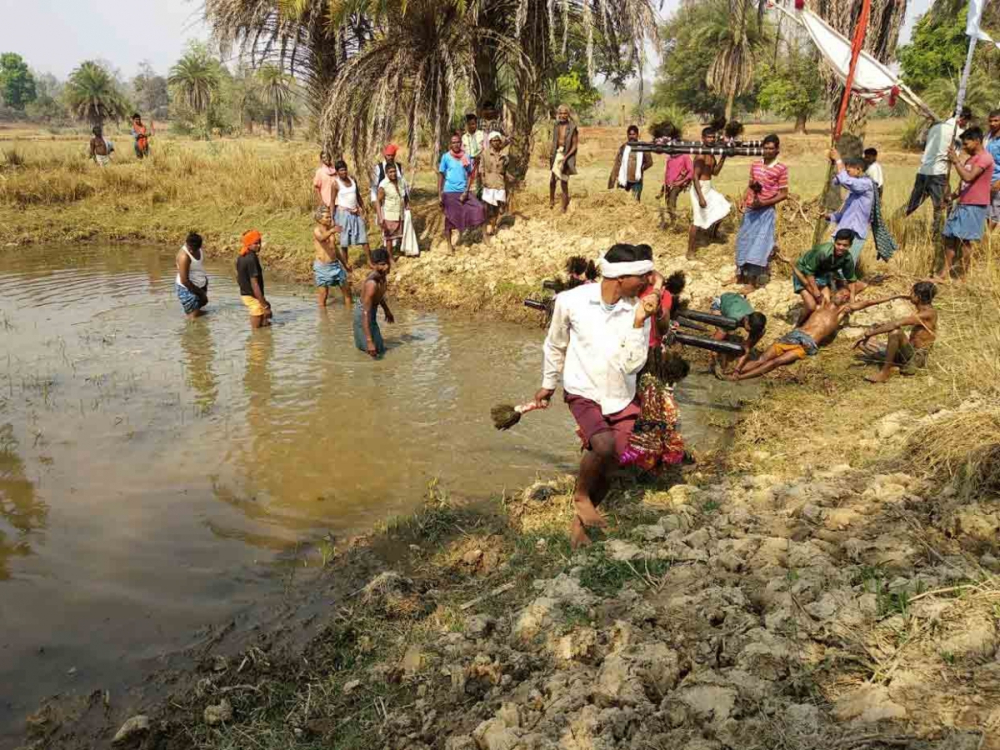
Men submerge themselves in the pond after they had been possessed by the divine deities
The pen karsar is also seen as a ritual which is necessary for the furman (well being) of the village and of the region.
The pen Madai of early April is also called the ama Madai as mangoes, which are locally called ama, are consumed after they have been offered to the ancestral gods. Apart from ama, in certain regions of Bastar, people also offer mariya, a coarse millet to their ancestors before they start consuming it. Mariya pej is a common gruel that Gonds, Marar, Ganda and other communities consume during the summer.
Madai entails a confluence in itself of various realms and within this confluence also resides the concept of the bazaar—a bazaar which will provide necessary materials in an extra material, spiritual and auspicious space. Most of the business in the bazaar occurs around the impending marriage season which follows immediately after the second week of April. The continuity of the adivasi society is maintained through the institution of family which in turn is regulated through a ritual of marriage. The bazaars of the Madai makes available for the adivasis all items that are required for a marriage.
The bazaar in Geedam
The ritual of the pen karsita, the procession and the parikrama of the chief deity along with the anga, dang and doli of their gods around the fair, literally marks the beginning of the fair in Geedam. Geedam being a bigger town, people from the surrounding villages gather there to sell and exchange their produce. Some sell their home-grown grains, paddy, millets, popped rice, vegetables, handmade baskets, brooms, drums, kakais (combs), while some also sell freshly brewed mahua and sulphi (toddy palm juice). Many forest dwellers bring with them a wide variety of herbs and fruits, such as char, tendu, bhel, behra, and lac, that they gather from the forest,. They sell these to buyers in exchange of money and then buy items of necessity. Most of the townfolk arrange for bigger stalls where they fry savouries such as samosa, kachori and a wide variety of sugar syrup based sweets; many traders from cities come to these fairs with their products and commodities. Silver jewellery and metal pot-makers are a very common sight. Transactions start soon after the ritual procession finishes its ceremonial rounds, and the gods are taken to the deo sthal (sheltered space) for resting. The market picks up pace throughout the day as buyers and sellers stream in; as evening falls, the Madai undergoes a transition. The nature of transaction shifts gears. From things of necessity people slowly start flocking in for entertainment. The throngs of village elders going from one seller to the other, buying cloth, jewellery and metal utensils, are replaced by younger crowds who come over for betting, dancing and singing.
However, one can also observe the transition in the nature of the bazaars taking place over the years; this transition is marked by the variety of goods and commodities that are available in the bazaar. One of the most striking features among many is the reduction in the number of hand-crafted goods, or goods that are rooted in the everyday lives of adivasi men and women. With the advent of mass produced manufactured goods and subsequent obsession with what are modern equipments, the glamour of these have outdone the elegance of handicrafts. Increasing urbanization and change in preferences has meant a decline in the demand of locally made products. Wooden toys for instance are increasingly losing out to the appeal of modern toys. The same is true for utensils where metal is gradually replacing earthen pots and wooden ladles. One finds about one or two venders of earthen and wooden utensils in the entire bazaar that would previously have at least 15 metal utensil vendors. Similarly, the bazaar is flooded with synthetic sarees and kids wear, accessories, denims and shirts, which are largely bought from the bigger urban centres, while one can hardly find traces of the unstitched cloth that was symbolic of the daily wear of the adivasi. Propelled by loss of demand and therefore loss of markets, by declining skills and by the rising difficulty of catering to newer markets, the art of crafts and that of craftsmen are slowly dwindling.

Glass bangles being sold in Madai
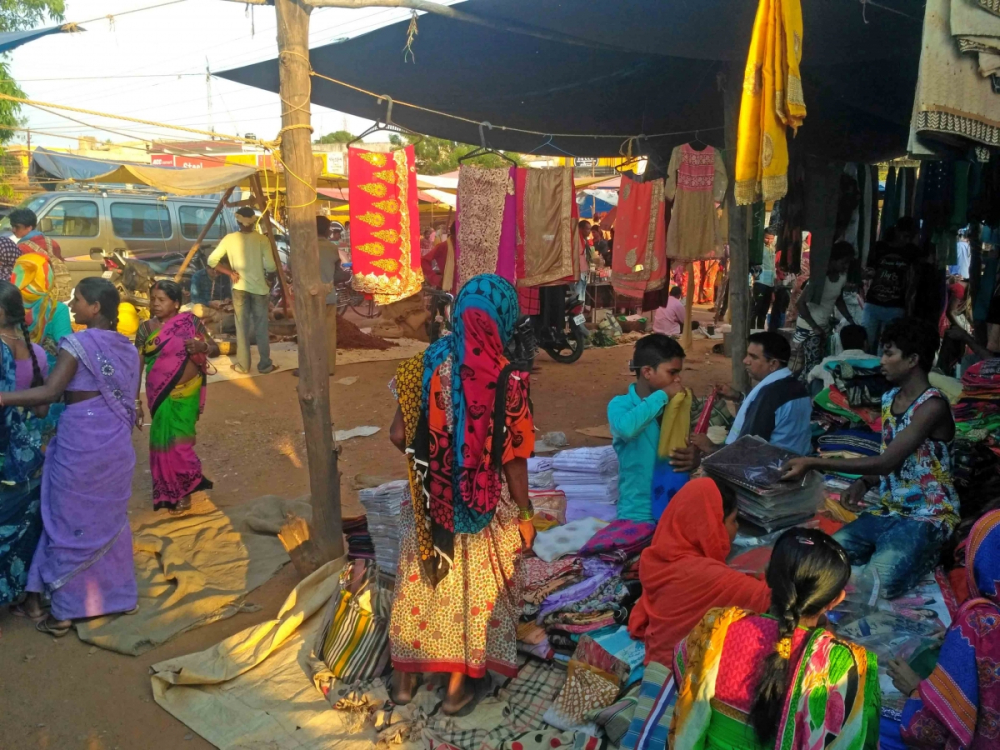
A cloth and garment shop in Madai
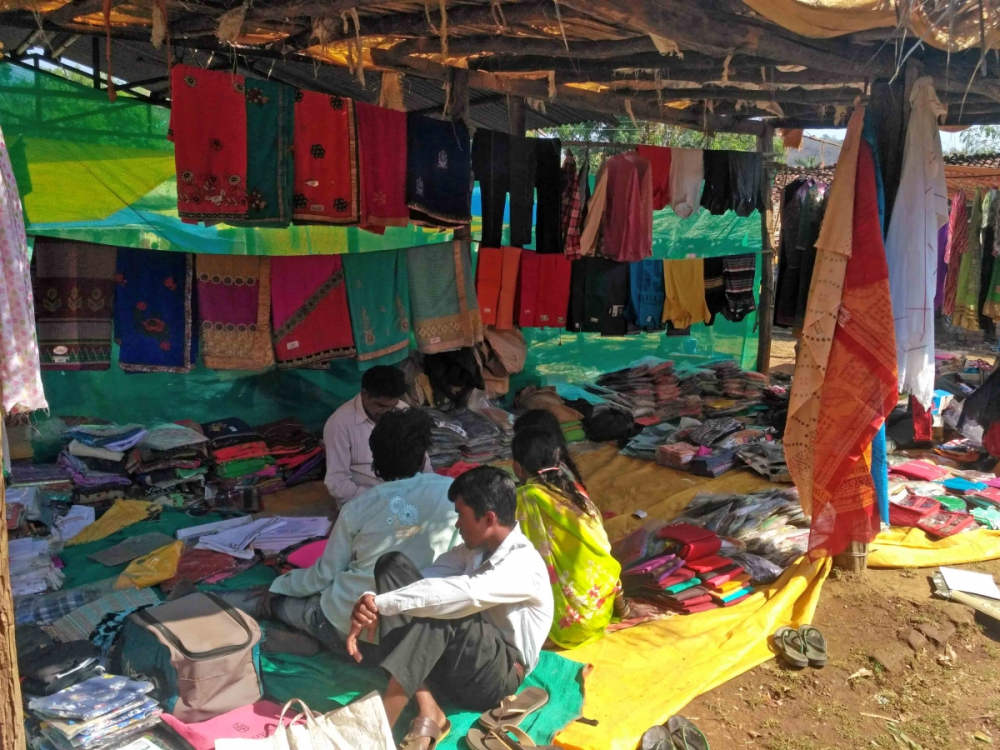
People buying clothes in bulk in preparation of upcoming wedding season
Next to the bazaar, certain spaces too change their nature with the advent of evening. Kukra bazaar or cock fights are organized, and chicken meat sellers and their wives light their earthen hearths to cook meat.

Cock-fights in Madai
The deo sthal is prepared for dances and groups of men and women start singing rela songs and dance to the rhythm of mandar (drums). The dances in some Madais go on till late at night. People who come for Madai, often do not return home as many come on foot from miles away. They either stay back in shelters prepared by the Madai organizers, or walk down to the homes of their nearest relatives.
Over the years, certain aspects of the Madai have not changed in many places but certain other aspects have undergone a radical change. Globalization has started shaping the bazaar of the Madai as 'need' is slowly replaced by fancy. Predictably the Madais of the bigger towns, such as Geedam, Jagdalpur and Dantewada, are slowly moving towards a space driven by fancy. The smaller village Madais, where modernity is yet to make an inroad, are still holding on to their traditional nature.
References
Bindu, B. ‘The 3Ds- Dantewada, Danteshwari and Dusshera.’ Online at https://www.unexploredbastar.com/dantewada-danteshwari-dusshera: Unexplored Bastar (viewed on May 12, 2018).
——— ‘Unexplored Bastar.’Online at https://www.unexploredbastar.com/jagdalpur: Jagdalpur: Gateway to destination to Bastar (viewed on May 12, 2018).
